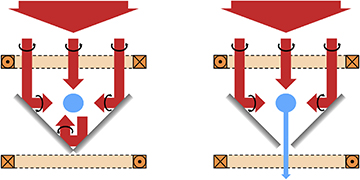![]()
Researchers in the UK have demonstrated a compact cold-atom source made from four mirrors in the shape of an upside-down pyramid, which opens and closes to produce an atomic beam whose flux can be optimized. [Image: Christopher Foot, Oxford University]
Sources of cold atoms are being developed for an ever-wider range of applications, from timekeeping and surveying of Earth’s gravity to testing general relativity and searching for dark matter. But before such devices can really take off—literally as well as metaphorically—they need to become less bulky and complex.
Now, researchers in the UK have built a new type of compact cold-atom source based on a magneto-optical trap that involves a pyramid-shaped arrangement of mirrors (Opt. Express, doi: 10.1364/OE.423662). They have shown that the device outperforms all other similar small-scale sources, and reckon that its simple construction makes it ready for commercialization.
Current clocks: Precise but bulky
Cooling atoms to temperatures of just a fraction of a degree above absolute zero generally involves exposing a gas of atoms to a set of laser beams arranged at a variety of angles. By setting the laser frequency at just below that of the main atomic transition, the Doppler shift can be exploited to slow down those atoms that approach the beams head on, leading to a rapid reduction in the atoms’ kinetic energy.
Among the many devices that rely on this laser cooling are the cesium fountain clocks housed in metrology laboratories that currently serve as the bedrock of world time. These exploit a specific cesium transition to calibrate a microwave oscillator, with the very low temperatures ensuring that the atoms move slowly enough for precise measurements and experience very little fluctuation in frequency. Atomic clocks also keep time in space and in the future might make global positioning more robust. But the most precise clocks are currently too bulky to be flown.
Pyramid scheme

In a pyramid-shaped magneto-optical trap (left), atoms are cooled and trapped (blue circle) when the pyramid is illuminated in the presence of a spherical quadrupole magnetic field. The pyramid cold-atom source in the new work (right) opens an aperture at the pyramid apex, leading to a reflection-free “exit” region where the intensity imbalance pushes cold atoms out through the aperture. [Image: S. Ravenhall et al., Opt. Express, doi: 10.1364/OE.423662]
In the recently published research, Chris Foot and Sean Ravenhall of Oxford University together with Benjamin Yuen, now at Birmingham University, show how much smaller clocks could be made by arranging mirrors in the shape of a pyramid. By exposing a gas of atoms inside the pyramid to a suitable magnetic field and illuminating them with a laser beam, the atoms are cooled down to very low temperatures. The trick is to make an aperture at the apex of the pyramid, since this creates a region, known as the exit channel, without any reflected light—leading to a net force pushing the atoms out of the pyramid in the form of a slow beam.
This arrangement requires just a single, large-diameter laser beam, making it more compact and robust than rival cold-atom sources. But while scientists have been working on such devices since the late 1990s, all so far have featured fixed apertures. The aim of the new work was to build a pyramidal trap with an aperture whose size can be varied, in order to optimize the source’s parameters.
The device consists of four identical reflective surfaces made from either glass or metal and coated with dielectric. Each reflector is shaped like a triangle with a curved lower edge such that together they form an inverted pyramid with the corners truncated to make it more compact. By allowing the reflectors to move along straight grooves on a circular plate and then rotating that plate, the apex of the pyramid can be made to open and close, yielding a square aperture of varying dimensions.
(Apeture) size matters
To test the device, which has a diameter of about 6 cm, the researchers exposed a gas of rubidium-87 atoms to 390 mW of collimated light from a titanium-doped sapphire laser while immersing the device in a spherical quadrupole magnetic field. They then used absorption spectroscopy to measure the flux of cold atoms streaming out through the aperture.
By varying the aperture between about 0.5 mm and 2 mm, they achieved a maximum flux with a size of about 1.4 mm—yielding 21 billion refrigerated atoms per second. What’s more, they found that this flux dropped by only 20% when they halved the laser intensity, making it greater than that from any other pyramid source to date. The only sources that have higher fluxes, they say, are very large devices that cannot be easily operated outside a laser laboratory.
As to why the size of the aperture should matter, the researchers hypothesize that when it is very large it creates a wide exit channel within which uncooled atoms are more likely to stray and, having higher velocities, to cross before reaching the aperture. When too small, on the other hand, the resulting narrow channel can be crossed even by more sluggish atoms. The result in both cases is that these atoms do not join the output beam, so reducing the flux.
The researchers acknowledge that pyramid-based sources do have their drawbacks. For one thing the optics are located inside the vacuum chamber, meaning that they are inaccessible for cleaning or repair (although the reflecting surfaces are protected, so maintenance is less likely to be needed). They argue that this should not prove to be a showstopper, and that the low power consumption combined with the small size of their device makes it suitable for commercial application. The limited number of components and assembly steps needed, they say, means that scaling up production “would be straightforward.”
